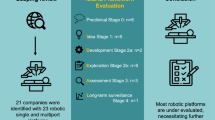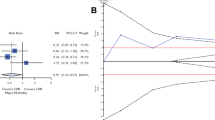Abstract
Background
Robotic surgery has emerged as one of the most promising surgical advances since its launch at the turn of the millennium. Despite its worldwide acceptance in many different surgical specialties, the use of robotic assistance in the field of hepatobiliary and pancreatic (HBP) surgery remains relatively unexplored. This article aims to evaluate the efficacy and outcomes of robotic HBP surgery in a single surgical center.
Methods
Between May 2009 and December 2010, all patients admitted to our unit for robotic HBP surgery were evaluated. A retrospective analysis of a prospectively maintained database on clinical outcomes was performed.
Results
There were 55 robotic HBP operations performed during the study period. There were 27 robotic liver resections (left lateral sectionectomies n = 17, left hepatectomy n = 1, other segmentectomies n = 2 and wedge resections n = 7), 12 robotic pancreatic procedures (Whipple’s operations n = 8, spleen-preserving distal pancreatectomies n = 2, double bypass n = 1 and cystojejunostomy n = 1) and 16 biliary procedures (biliary enteric bypass n = 9, bile duct exploration and related procedures n = 7). The median postoperative hospital stays for robotic liver resections, biliary procedures and pancreatic operations were 5.5 days (range 3–11 days), 6 days (range 4–11 days) and 12 days (range 6–21 days), respectively. Morbidities for liver resection, biliary procedures and pancreatic operations were 7.4, 18 and 33%, respectively. There was no mortality in our series.
Conclusions
Robotic surgery is feasible and can be safely performed in patients with complicated HBP pathologies. Further evaluation with clinical trials is required to validate its real benefits.





Similar content being viewed by others
References
Idrees K, Bartlett DL. Robotic liver surgery. Surg Clin N Am. 2010;90:761–74.
Scott DJ, Young WN, Tesfay ST, et al. Laparoscopic skills training. Am J Surg. 2001;182:137–42.
Smith CD, Farrel TM, McNatt SS, et al. Assessing laparoscopic manipulative skills. Am J Surg. 2001;181:547–50.
Patel HP, Linares A, Joseph JV. Robotic and laparoscopic surgery: cost and training. Surg Oncol. 2009;18:242–6.
Maeso S, Reza M, Mayol JA, et al. Efficacy of the Da Vinci Surgical System in abdominal surgery compared with that of laparoscopy, a systematic review and meta-analysis. Ann Surg. 2010;252:254–62.
Waters JA, Canal DF, Wiebke EA, et al. Robotic distal pancreatectomy: cost effective? Surgery. 2010;148(4):814–23.
Choi SB, Park JS, Kim JK, et al. Early experiences of robotic-assisted laparoscopic liver resection. Yonsei Med J. 2008;49(4):632–8.
Buchs N, Addeo P, Bianco FM, et al. Outcomes of robot-assisted pancreaticoduodenectomy in patients older than 70 years: a comparative study. World J Surg. 2010;34:2109–14.
Giulianotti PC, Sbanan F, Bianco FM, et al. Robot-assisted laparoscopic pancreatic surgery: single-surgeon experience. Surg Endosc. 2010;24:1646–57.
Ntourakis D, Marzano E, Penza PA, et al. Robotic distal splenopancreatectomy: bridging the gap between pancreatic and minimal access surgery. J Gastrointest Surg. 2010;14:1326–30.
Tan GY, Goel RK, Kaouk JH, et al. Technological advances in robotic-assisted laparoscopic surgery. Urol Clin N Am. 2009;36:237–49.
Nguyen KT, Geller DA. Laparoscopic liver resection—current update. Surg Clin N Am. 2010;90:749–60.
Ito K, Ito H, Are C, et al. Laparoscopic versus open liver resection: a matched pair case control study. J Gastrointest Surg. 2009;13(12):2276–83.
Lai EC, Tang CN, Yang GP, et al. Minimally invasive surgical treatment of hepatocellular carcinoma: long-term outcome. World J Surg. 2009;33(10):2150–4.
Vanounou T, Steel J, Nguyen KT, et al. Comparing the clinical and economic impact of laparoscopic versus open liver resection. Ann Surg Oncol. 2010;17(4):998–1009.
Giulianotti PC, Coratti A, Sbrana F, et al. Robotic liver surgery: results for 70 resections. Surgery. 2011;149:29–39.
Ji WB, Wang HG, Zhao ZM, et al. Robotic-assisted laparoscopic anatomic hepatectomy in China, initial experience. Ann Surg. 2011;253:1–7.
Berber E, Akyildiz HY, Aucejo F, et al. Robotic versus laparoscopic resection of liver tumors. HBP (Oxford). 2010;12(8):583–6.
Buell JF, Cherqui D, Geller DA, et al. The international position on laparoscopic liver surgery: the Louisville statement, 2008. Ann Surg. 2009;250(5):825–30.
Roeyen G, Chapelle T, Ysebaert D. Robot-assisted choledochotomy. Surg Endosc. 2004;18:165–6.
Ruurda JP, van Dongen KW, Dries J, et al. Robot-assisted laparoscopic choledochojejunostomy, comparison to the open approach in an experimental study. Surg Endosc. 2003;17:1937–42.
Jayaraman S, Davies W, Schlachta CM. Robot-assisted minimally invasive common bile duct exploration: a Canadian first. Can J Surg. 2008;51(4):93–4.
Giulianotti PC, Sbrana F, Bianco FM, et al. Robot-assisted laparoscopic extended right hepatectomy with biliary reconstruction. J Laparoendosc Adv Surg Tech A. 2010;20(2):159–63.
Tang CN, Tsui KK, Ha JP, et al. Laparoscopic exploration of the common bile duct: 10-year experience of 174 patients from a single centre. Hong Kong Med J. 2006;12:191–6.
Melvin WS. Minimally invasive pancreatic surgery. Am J Surg. 2003;1863:274–8.
Chang MK, Dong HK, Woo JL. Ten years of experience with resection of left-sided pancreatic ductal adenocarcinoma: evolution and initial experience to a laparoscopic approach. Surg Endosc. 2010;24:1533–41.
Conflict of interest
We certify that we have no conflict of interest or relevant financial interest in this article.
Author information
Authors and Affiliations
Corresponding author
About this article
Cite this article
Chan, O.C.Y., Tang, C.N., Lai, E.C.H. et al. Robotic hepatobiliary and pancreatic surgery: a cohort study. J Hepatobiliary Pancreat Sci 18, 471–480 (2011). https://doi.org/10.1007/s00534-011-0389-2
Published:
Issue Date:
DOI: https://doi.org/10.1007/s00534-011-0389-2




